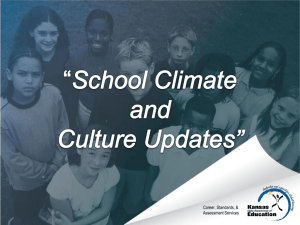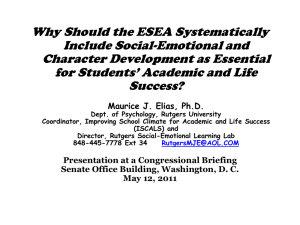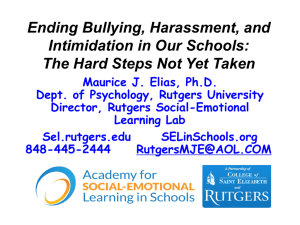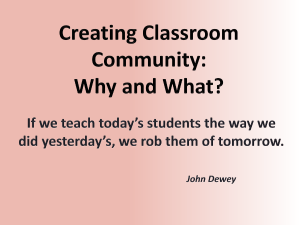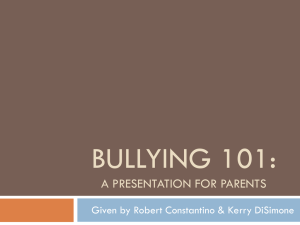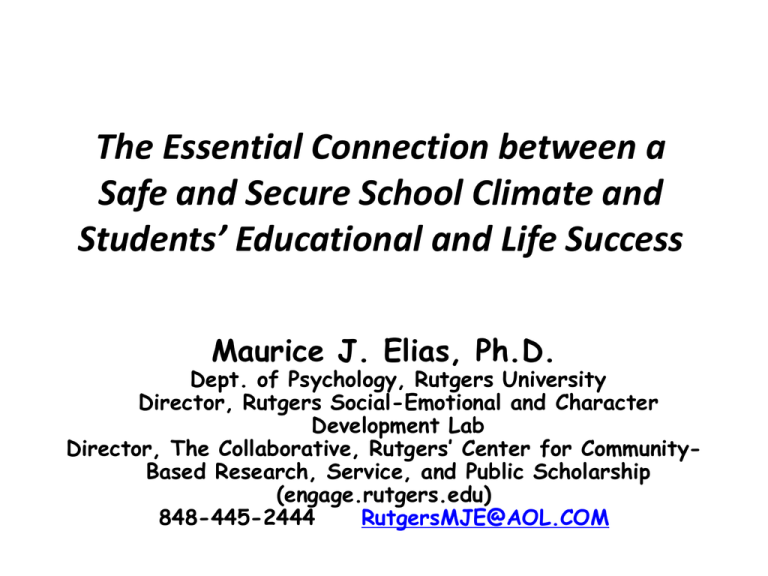
The Essential Connection between a
Safe and Secure School Climate and
Students’ Educational and Life Success
Maurice J. Elias, Ph.D.
Dept. of Psychology, Rutgers University
Director, Rutgers Social-Emotional and Character
Development Lab
Director, The Collaborative, Rutgers’ Center for CommunityBased Research, Service, and Public Scholarship
(engage.rutgers.edu)
848-445-2444
RutgersMJE@AOL.COM
How Would You Like Your Children to be
Treated in School?
How about your
Grandchildren?
If You Had a Magic Wand, What Values Would You
Wish Your Children Would Internalize Forever?
• Friendship
• Peace
• Wisdom
• Beauty
•Long Life
•Riches
•Popularity
•Family
challenges our youth carry
around with them each day
•
•
•
•
•
•
Increased pace of life
Greater economic demands on parents
Alterations in family composition and stability
Breakdown of neighborhoods and extended families
Weakening of community institutions
Unraveling of parent-child bonds due to work, school demands, time,
drugs, mental health, and economic burdens
• Climate of war, terror, and societal violene, bullying and intimidation
• Ongoing exposure to an array of digital media and pervasive
advertising that encourage violence as a problem-solving tool and
other health-damaging behaviors and unrealistic lifestyles
Attainable School Safety and
Security Through Relationships
• When we open our doors for children to come into our schools,
we have a special responsibility to educate them in mind, heart,
body, and spirit/ethics. We have no choice but to do all four of
these.
• Students who are smart but not healthy, caring, or ethical are
dangers to society, not cherished sources of high test scores.
• Our children cannot learn, and our teachers cannot teach, in
schools that are unsafe, unsupportive, uncaring, uncivil or lacking
in intellectual challenge. These are the ultimate sources of
security to children and in ways that are more lasting than metal
detectors.
Social-Emotional and Character Development (SECD):
A Coordinated Framework Provides Synergy
School-Wide Efforts
Violence
Programs
without a
Common
Framework
Prev
Academic Skills
ATOD
Ed
Community Involvement
Sex Ed
Families
Health
Ed
SECD
A Common
Framework
Provides
Synergy
Violence
Sex Ed
Health
Ed
Academic Skills
Service Learning
ATOD Prev
Ed
Character Ed
SCHOOL-FAMILY-COMMUNITY PARTNERSHIPS
What is Social-Emotional and Character
Development (SECD)?
• a set of skills and dispositions/essential life habits
• that can be built developmentally if we do so with
intentionality, focus, and continuity, and
• schools are the place where most children can be
reached systematically,
• because the same set of skills and habits ultimately
mediate academic, civic, and workplace success
• and it relates to moral and performance character!
How Does SECD Work?
SECD is an evidence-based strategy that integrates the intellectual, emotional,
and social facets of learning. It works through two related approaches:
Positive,
CharacterBuilding
School
Climate
Explicit
Instruction
+
in SEL Skills
Source: SEL and Academics: Research Brief,
Collaborative for Academic, Social and Emotional Learning, 2007.
=
Positive
Results for
Children
What Skills are Needed for Success in School and
Life/Participatory Competencies?
Recognize one’s emotions,
values, strengths, and
limitations
Manage emotions
and behaviors
to achieve
one’s goals
Selfawareness
Selfmanagement
Show
understanding
and empathy for
others
Life
Success
Social
awareness
Responsible
decision
making
Relationship
skills
Make ethical,
constructive choices
about personal and
social behavior
Form positive
relationships, work
in teams, deal effectively
with conflict
Benefits of SECD
Good Science Links SECD to the Following Student Gains:
• Social-emotional skills
• Improved attitudes about self, others, and school
• Positive classroom behavior
• 10-11 percentile-point gains on standardized achievement
tests
And Reduced Risks for Failure:
• Conduct problems
• Aggressive behavior
• Emotional distress
Source: Durlak, J.A., Weissberg, R.P., Dymnicki, A.B., Taylor, R.D., & Schellinger, K. (2011). The Impact of Enhancing
Students’ Social and Emotional Learning: A Meta-Analysis of School-Based Universal Interventions. Child Development.
(available at www.casel.org) and M. Berkowitz & M. Bier, What works in character education. (Washington, DC: Character
Education Partnership, 2006) (available at www.characterandcitizenship.org.)
Paths to Success in School and in Life:
Success Requires a Confluence of SECD and Classroom
and School Environment
EvidenceBased SECD
Programming
to Support
the
Whole Child
Safe, Caring,
Cooperative,
Well-Managed
Learning
Environments
Teach SECD/
Health/Civic
Participatory
Competencies
Provide
Opportunities for
Positive Contributions,
Recognition, and
A Sense of Purpose
And Pride in Being
Part of the School
Less Risky
Behavior, More
Assets, &
Positive
Development
Greater
Attachment,
Engagement, &
Commitment
to School
Better
Academic
Performance
and Success
in School
and Life
The mandate We Carry
Forward
•There are many dimensions to safety and all of them are
equally important.
•Our children need to be partners in creating safe, civil, caring
schools.
•As a matter of public health, as well as education, we must
invest in safe and civil schools through SECD.
•What children need from us is to prepare them for the tests of
life, not a life of tests.
Summary of Research Evidence on the Impact of
School Climate/Belonging on Harassment,
Intimidation, and Bullying, and Academics
“There is … powerful evidence that school climate affects
students’ self-esteem and self-concept. School climate also
colors school-based risk-prevention efforts. Effective riskprevention and health-promotion efforts are correlated with a
nurturing school climate. It also promotes academic
achievement. As a result of these findings, fostering socially,
emotionally, and physically safer schools has become a
primary focus of the U.S. Department of Justice and virtually
all state education departments.” (Cohen, 2006, p. 212-213.)
HIB is a school organizational/values problem that
requires strong policy and follow-up for prevention and
response. It can be addressed effectively.
From Cohen, J. (2006). Social, Emotional, Ethical, and Academic Education: Creating a Climate for
Learning, Participation in Democracy, and Well-Being. Harvard Educational Review, 76 (2), 201-237.
DSACS Data on
Bully-Climate- Voice Connection
•
•
•
Data from Years 3 and 4 of the DSACS project, the first
years in which we collected anonymous data on
students’ perception of bullying.
We examined the relationship between the degree of
bullying in school and the extent to which students felt
they were being given useful strategies to handle
bullying, and their perception of the school climate. The
overall data set represents 115 schools and 48 districts,
and 48,000 students, across the full range of DFG’s in NJ,
across the entire state geographically.
Across all data sets for both years, for disadvantaged
schools vs. others, and for elementary, middle, and high
schools, the finding were remarkably consistent.
Key Findings
• Bullying is related to the climate of the
school and is most strongly and
significantly related to the respect that
students feel in the school, especially
among their peers.
• Where there is a respectful environment,
bullying is less likely to exist in schools.
Key Findings
• The extent to which students feel they are truly
learning strategies to cope with HIB in their
schools is most strongly related to the:
extent to which they perceive teachers as
being caring and supportive to students and
to one-another, and secondarily to
extent to which students feel they are
involved in shaping their school environment
in positive ways.
• Students appear to find HIB prevention and
intervention messages valuable when staff
members are seen as genuinely caring and when
students are engaged in the school.
The High School Study
• 21 high schools in 2008-9, 13,593 students in the
sample; all SES levels included
• Bullying correlates between -.72 and -.89 with the
following climate indicators:
•
•
•
•
•
•
•
Student Respect Friendliness and Belonging
Students Shaping Their Environment
Support and Care By and Among Staff
Student Approval
Student Perceptions Of Utility Of Learning
Teacher Approval (How much teachers like the school)
Overall Climate (Average of 16 variables)
School Climate and NJ H.S. Violence
and Vandalism Data (EVVRS)
We looked at the relationship of school climate to overall count
of incidents on EVVRS for 08-09 (EVVRS-TOT), incidents of
violence (EVVRS-VIOL), vandalism (EVVRS-VAND),
substance abuse (EVVRS- ABUSE), and weapons
possession (EVVRS-WEAP):
• Overall Climate r = -.44 (TOT), -.41 (VIOL)
• Students Shaping Environment r = -.48 (TOT), .43 (VIOL)
• Teacher Approval/Liking of School r = -.44 (TOT), .45 (VIOL), -.65 (ABUSE)
• Student Pride in School r = -.62 (TOT), -.58
(VIOL), -.41 (ABUSE)
• Support and Care By and Among Staff
r = -.41 (ABUSE)
Successful 21st Century Schools Understand
and Emphasize That:
Systematic, comprehensive, and effective
approaches to school-wide SECD and a safe,
challenging, caring, supportive, and healthy
climate are essential components of all
students’ academic and life success.
Key Recommendations to
Guide Policy
• Every school should undertake a systematic
assessment of staff and student perceptions of
school climate, including school safety/bullying and
student engagement/participation/voice, at least once
every two years and use that feedback in a staff-wide
data review for systematic improvement of SECD
competencies and school climate in schools that have
a clear sense of meaning and purpose. (In Middle and High
Schools, students should be involved in the data review and planning
process.)
Key Recommendations to
Guide Policy
• Each student should receive a minimum of one-half
hour of explicit instruction per week in skills
related to social-emotional and character
development (SECD) as part of a comprehensive
prek-12 scope and sequence (see Anchorage, Alaska, public schools
for an example of such a framework, as well Appendix C of CASEL's Promoting
Social and Emotional Learning: Guidelines for Educators).
• Every teacher, student support services provider, and
administrator should have demonstrated competence
in implementing evidence-based SECD programming
and positive climate promotion at the classroom
and/or school level (as appropriate).
Key Recommendations to
Guide Policy
• Schools require implementation support
systems for long-term sustainability of
effective innovations– this involves
infrastructure, collaboration with others doing
this work, and a commitment to deep
understanding of how SECD, climate, and
academics fit together
Research Confirms Long-Held
Good Sense
• To educate a person in mind and not in morals is to educate a
menace to society. -- Theodore Roosevelt
• We are going to ask our children not just to talk but to act,
serve, and live in accordance with a set of higher values and
with a buoyant optimism.-- R. Sargent Shriver
• If we ignore the practical need that students have for skills
that will enable them to participate fully in our society, they
will be unable to compete for jobs or understand what is
expected of them in order to participate as informed citizens in
our democracy.– Boykin & Noguera
• Intelligence plus character - that is the goal of true education. -Rev. Dr. Martin Luther King, Jr.
Small Steps Toward a
Great Journey:
How Shall We Proceed to Get to Where We
Know We Must Go?
You Cannot Effectively Advocate for
What You Do Not Show: The Courage
of your Character Convictions
“Don’t let what you
cannot do interfere
with what you can do.”
John Wooden
“The children are waiting.”
Ted Sizer
Essential Programmatic Steps
• Increasing Youth Voice, Engagement,
Genuine Participation
• Integrating SECD Skills/Character
Themes into Academic Instruction
Best Practices for Fostering Youth Engagement
and Building Students’ SECD
•
•
•
•
•
•
•
•
•
Meaningful, Participatory Student Government
Service Learning-- Lions-Quest International
Feedback/Sharing Opportunities
Open Forums for School Problem Solving
Staff/Student Committee Involvement
Having a Voice/Diversity Monitoring
Buddies, Mentors, and Tutors
Opportunities for Reflection
Opportunities for Identifying and Developing
one’s Laws of Life
Integration of SECD into
Lessons
Reading
Written Expression
Use feelings vocabulary
in journal entries, poetry,
essay writing; read
wordless books
Identify how
passages reflect
emotions
FEELINGS
Draw where
people feel
emotions; feelings
and colors
Math
Collect and graph
“feelings” data; track
emotions during
problem solving
Computer
Literacy
Computer generated
illustrations of feelings;
download songs
reflecting emotions
Art
SECD Lessons
Build skills via games,
videos; practice with
role plays and application
to group work
Integration of SECD into
Lessons: Fill in the Blanks
Reading
Art
Written
Expression
Responsibility
Social Studies
SECD Lessons
Math/
Other Subject
Background:
The Laws of Life Essay Journey
• What is the Laws of Life Essay Journey?
• Case example: Plainfield Public School District,
Plainfield, NJ and the book, Urban Dreams
• Extending the effects into everyday interactions,
homes and communities: Learning to live one’s
Laws of Life (not really a paradox….)
Values-Linked Goal-setting
Contracts
• Step-by-step exercise to
help youth identify a goal
and make effective plans
for goal achievement
• A promise people make to
themselves
• Includes a “buddy” for
mutual accountability/
responsibility

